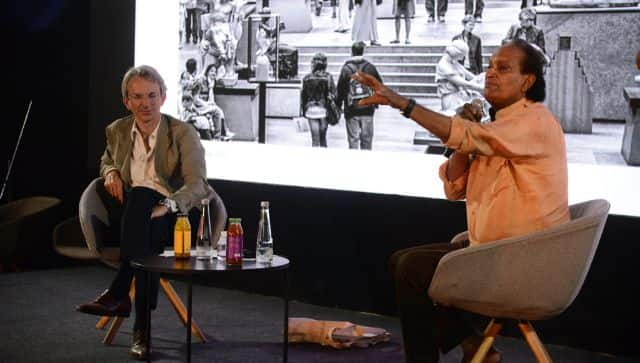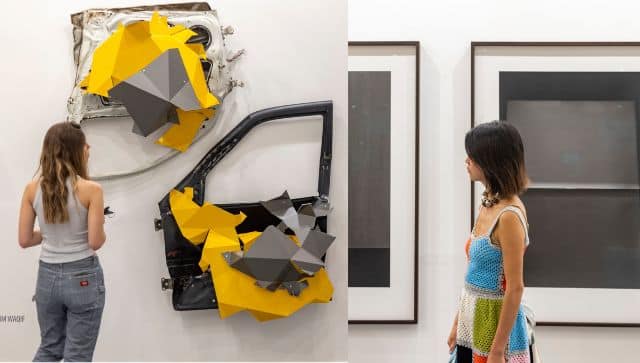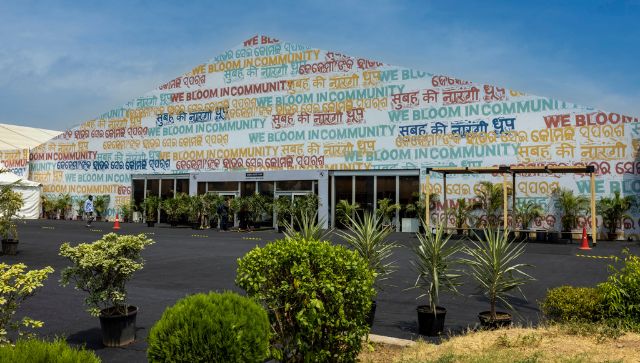Everyone in Delhi is a VIP. Or at least that’s what it felt like on the first day of the India Art Fair (IAF) 2022, which took place at Delhi’s NSIC Grounds in Okhla in late April. As an avid art enthusiast and budding art and culture writer, when I heard that the IAF was finally taking place after a number of postponements, my search for an all-access pass began in earnest. With some resourcefulness, I managed to get the digital VIP pass at the eleventh hour.
And so, on Thursday, April 28, I arrived in my ancient Honda City at 3 PM on the dot, only to navigate through endless rows of fancy Beemers, Audis and Mercs for VIP entry from Gate 5. It quickly dawned on me that the ‘BMW VIP Preview Day’ was limited neither in the number of invitees nor its scope. With many parallel events spread across Delhi-NCR and noteworthy additions such as spaces dedicated to digital art, photo books, and other newer mediums; the IAF 2022 was quite different from its previous editions.
On the opening day, passes checked and entry gained, the VIPs were photographed at pre-fixed spots in front of the Studio & Workshop Space whose exterior wall, adorned with an AI-generated NFT, made a picturesque backdrop. The curious among us made their way into the Studio, while collectors on a mission to get their hands on the best pickings in art, crossed the road for the main IAF enclosure.
I chose to explore the experimental over the established first and made a beeline for the much talked about AI version of Van Gogh’s ‘Starry Night’, excited to see myself in it. While there, I also had a chat with Hukum Singh, a strangely beardless Sikh parliamentarian, who was one of many ‘Radbots’ – AI-generated video bots with personalities – engaging in conversation with spectators. Another exhibit that caught my eye, or in this case - ear, was ‘SUNO’ which encouraged the listener to identify the site (Delhi’s Bhalswa landfill) on the basis of its sounds.
[caption id=“attachment_10651161” align=“alignnone” width=“640”]  Talk at the India Art Fair with Raghu Rai and Emmanuel Lenain[/caption]
After a leisurely stroll through the relatively empty Studio, I made my way to the main hall. This was a different ball game altogether - more the scene of a social outing than a serious trade fair. People starved of the company of their friends and acquaintances were keener on their selfies than on soulful reflections brought on my artwork. However, despite the defunct air conditioners and jostling crowds, it was clear the IAF 2022 was off to a great start.
As the days progressed and the venue was opened to the public, many braved Delhi’s heatwave to visit. For some, it was simply an Instagram photo op, but most were serious connoisseurs and buyers. “People have been buying art throughout the pandemic and it was lovely to see the IAF do very well too. At least three galleries that I know of – Chemould Prescott Road, Vadehra Art Gallery, and Gallery Espace were sold out. I particularly loved the fact that the galleries paid so much attention to the design dynamics of their displays this time. For example, though Atul Dodiya’s works were displayed by both Chemould and Vadehra, both treated his works so differently, in the way they were displayed,” says Uma Nair, respected Art Critic and Curator.
Nair curated Oritecture Artist Ankon Mitra’s parallel solo exhibit with Gallery Art Positive titled ‘A Pilgrim’s Progress’, on display at Bikaner House. Mitra was one of eight artists who got their first solo show at the IAF this year. Others included Ceramicist Vinod Daroz, Sculptor Christian Achenbach, Painter Thota Vaikuntam, British Artist Stephen Cox, multimedia Artist Sudip Roy, Ceramicist P R Daroz and Artist Chetnaa. While this talented bunch finally got their due, some galleries had retrospectives to commemorate the work of some of India’s masters. Kiran Nadar Museum of Art (KNMA) organised centenary retrospectives dedicated to two of India’s greatest artists – Sayed Haider Raza’s ‘Traversing Space’ at Bikaner House and Somnath Hore’s ‘Birth of a White Rose’ at their Saket space, both on view till June 30.
[caption id=“attachment_10651171” align=“alignnone” width=“640”]  Galeria Karla Osorio and Blueprint 12 installation shot with visitors[/caption]
With multiple simultaneous events and exhibits taking place at different locations throughout Delhi-NCR, art lovers were spoilt for choice. Our days were spent browsing the booths at the main venue, attending insightful and often entertaining talks such as the BMW Art Talk with Shireen Gandhy of Chemould Prescott Road and Atul Dodiya, and sampling the fancy fare being served at Caara and Café Dali’s kiosks. The evenings were spent hopping from one exhibit launch to another at venues like the India Habitat Centre, Bikaner House, the Italian Embassy, Stir, and the Museum of Retrieved Antiquities in Purana Qila; and the nights were spent partying till the wee hours.
People with a stake in the art world pulled out all stops to host colourful parties, many of which overlapped with each other. Day three of the IAF, also a Saturday night, had a lot going on. From the event where Chemould partnered with fashion label Bodice to Raw Mango’s iconic ‘Baithak’, Stir’s ‘Folk it All’ to Soho House x Crayon Art Gallery’s ‘The Art Party’. But it was the last of these that boasted the most illustrious guest list which included Theodore Apollo Johnson – the youngest son of Britain’s Prime Minister. The entry of the farmhouse venue was bedecked with digital art shown on massive screens, and the owners’ envious art collection was on display throughout their gorgeous home. Attendees ranged from regulars of Delhi’s party scene dressed in their fanciest best to art world stalwarts who stumbled in wearing their comfort Khadis straight from the IAF. Though I left at a tame 1 am, the party reportedly went strong till 5 in the morning, with young art collectors proving that they know their art as well as their parties.
The emergence of young collectors was another noteworthy development in this IAF. Through its ‘Young Collector’s Programme’, the team at IAF attempted to demystify the intimidating world of art. Their widespread ‘IAF Parallel’ programmes ran at galleries and art spaces simultaneously throughout the country, encouraging young people to learn about art in their own cities. Through their ‘IAF stories’ video blogs, they shared information on Indian artists and their work. Most importantly, the art itself was priced very competitively, to appeal to a variety of budgets. As many of my friends and contemporaries indulged in artworks big and small, fixed and digital, traditional and quirky; it became clear that the plan to encourage younger people to dip their toes in these waters, had worked.
The IAF 2022 will go down in history as an event of many firsts – it proved that a love of art surpasses extreme heat and Covid waves, showed that the best way to increase access to art is by spreading its wings across the country, highlighted that art is the bridge between the past and a fast-paced modern world, and most importantly, ensured its continued survival by encouraging and shaping future art collectors.
Noor Anand Chawla pens lifestyle articles for various publications and her blog www.nooranandchawla.com.
Read all the **_Latest News_** _, _ **_Trending News_** _, _ **_Cricket News_** _, _ **_Bollywood News_** _, _ **_India News_** and **_Entertainment News_** here. Follow us on Facebook_, _ Twitter and Instagram_._


)
)
)
)
)
)
)
)
)



